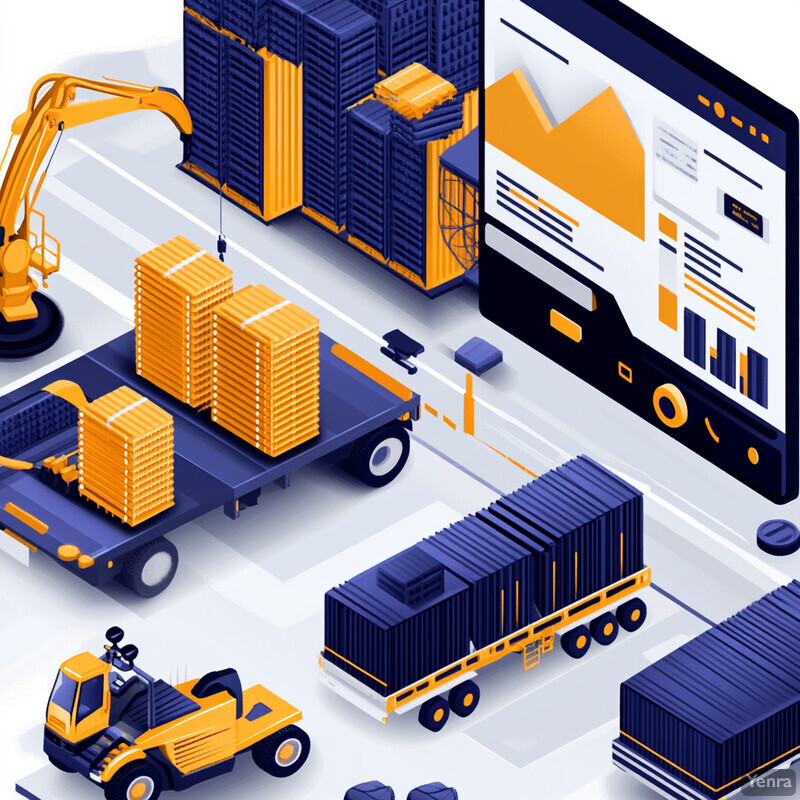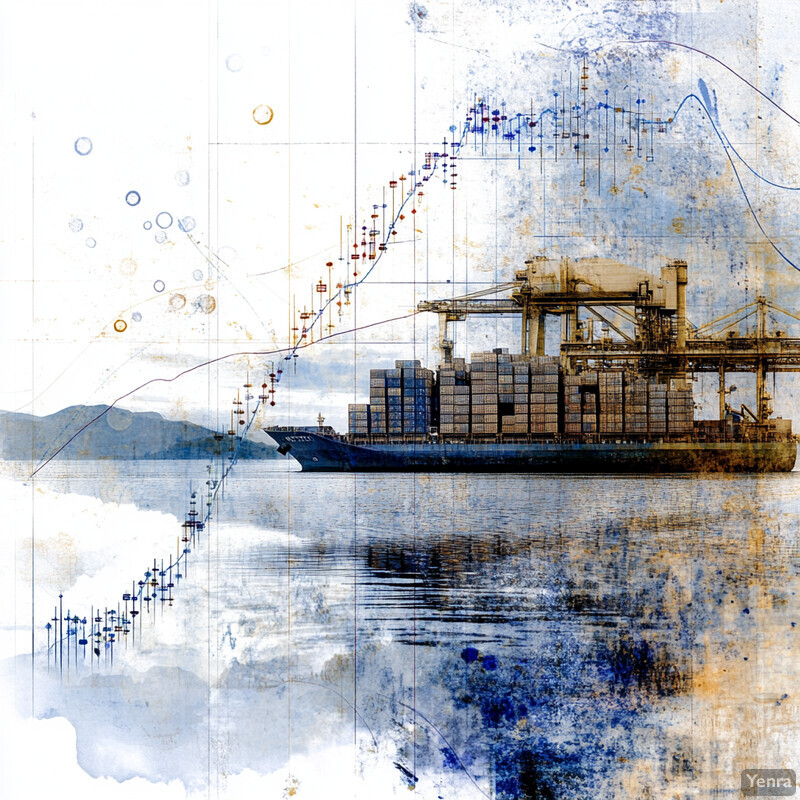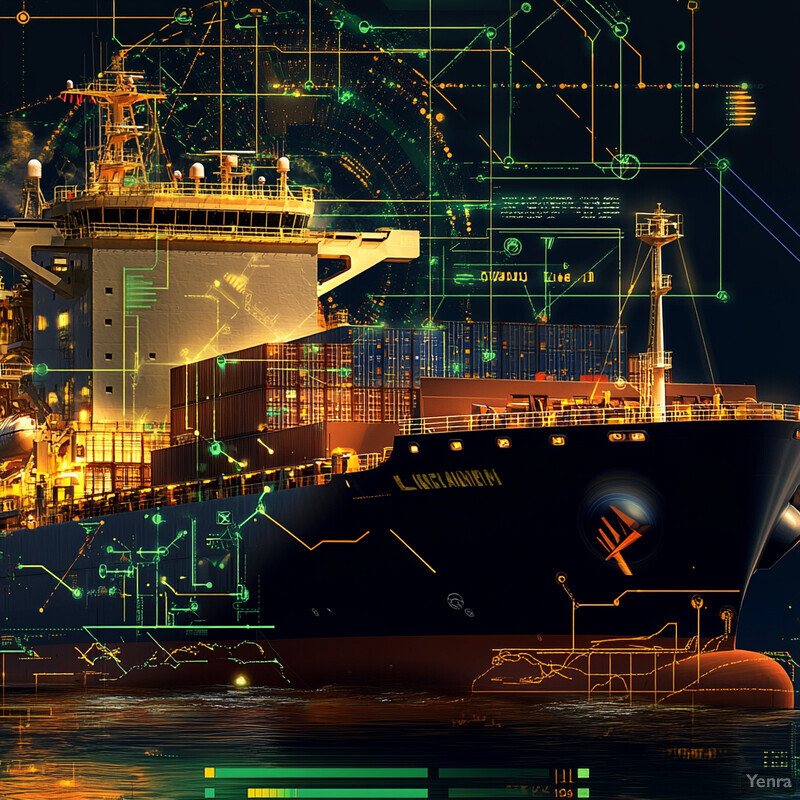1. Enhanced Data Integration
AI enables consolidation of diverse data sources (historical rates, weather, port congestion, IoT, etc.) into unified forecasting models. This holistic integration yields more comprehensive and reliable freight price predictions. Integrated data provides planners a single coherent view, reducing blind spots and enabling faster, data-driven decisions. In practice, companies build data lakes or knowledge graph–based systems to harmonize structured and unstructured data for analytics. The net impact is smoother information flow across the supply chain, allowing planners to trust forecasts that reflect all relevant market drivers. This reduces guesswork in pricing and helps companies adapt faster when market conditions change.

Modern forecasting systems ingest structured (e.g. transaction records), semi-structured (e.g. AIS logs), and unstructured (e.g. news text) data through advanced integration pipelines. Knowledge graphs in supply chains, for example, merge ERP, IoT, and news feeds into unified representations of entities and relationships. Graph neural networks can then operate on this rich data structure, capturing relationships among shippers, routes, commodities, and economic indicators. Machine learning models also use feature engineering to align heterogeneous data streams in time, enabling simultaneous analysis. Research shows that a knowledge-graph approach provides a flexible, scalable way to integrate diverse information and address data fragmentation, yielding better predictive insights. In effect, AI-driven integration turns raw data deluge into actionable signals for pricing models.
2. Real-Time Market Monitoring
AI systems continuously track live market signals—such as current spot rates, vessel positions, commodity indices, and breaking news—to adjust freight forecasts dynamically. This capability means forecasts instantly reflect the latest supply-demand shifts and disruptions. For example, rapid changes in spot freight indices or port congestion alerts can automatically update model inputs, producing fresh forecasts within hours rather than days. The practical benefit is faster response to volatility: planners can lock in rates or adjust routes before price swings materialize. This dynamic monitoring also helps catch early indicators of rate swings (e.g. a surge in spot rates hinting at rising contract rates). Overall, real-time AI monitoring keeps forecasts up to date, improving decision lead times and reducing unexpected rate shocks.

Modern forecasting platforms ingest streaming data feeds through APIs or IoT networks, using online learning algorithms to update models incrementally. For instance, Liachovičius et al. showed that current spot freight rates are strongly correlated (0.86) with contract rates and can be used as live inputs for contract forecasting. In practice, machine learning pipelines can connect to real-time freight indices (e.g. Baltic Dry Index, Freightos), social media sentiment, and port traffic feeds. Models like online gradient-boosting or recurrent networks then immediately re-train on new data or apply real-time predictions. Advanced analytics (including anomaly detection) flag sudden deviations (like a weather disruption), triggering fast model recalibration. Research indicates that when AI-based models use live spot rates and high-frequency data, they outperform static methods in capturing short-term market moves. This real-time feedback loop enhances accuracy and agility.
3. Improved Forecasting Accuracy via Deep Learning
Deep learning models (such as recurrent networks or transformers) can capture complex, nonlinear patterns in freight data that traditional statistical methods miss. This leads to notably higher forecast accuracy, especially over longer horizons and in volatile periods. The impact is more dependable rate predictions that better reflect market dynamics (for example, sudden cyclical surges or ramp-ups after a disruption). Higher accuracy reduces cost overruns and improves tendering and contract pricing decisions. In practice, companies observe that AI models detect subtle demand shifts and supply bottlenecks faster than older methods, smoothing rate swings. This heightened precision has become crucial as data volumes grow, meaning forecasts are both more robust and actionable.

Deep learning architectures like LSTM or Transformer networks incorporate large historical and multivariate inputs to learn time-series dependencies. They can automatically handle seasonality, trends, and cross-correlations without manual feature design. Studies confirm deep models often beat classic models: Liachovičius et al. found a multilayer perceptron (a type of neural network) significantly outperformed ARIMA-based forecasts for freight rates. Likewise, recent benchmarking shows graph neural networks (a deep learning approach) improve forecasting error by 10–30% over traditional ML or linear models in supply-chain tasks. These models train on vast datasets, learning from thousands of freight routes and exogenous indicators, then apply nonlinear transformations to predict future rates. By learning hidden data patterns (e.g. how fuel prices affect long-term trends, or holiday season spikes), deep learning delivers more reliable forecasts. This technical advantage translates into fewer surprises in budgeting and better alignment with actual market behavior.
4. Scenario Analysis with Simulation Models
AI-driven simulation tools allow planners to run “what-if” scenarios (e.g. a trade embargo, port strike, or sudden demand surge) and quantify their effects on future freight rates. This capability makes forecasting more resilient by preparing for a range of outcomes. The practical benefit is that decision-makers can evaluate contingency plans in advance, rather than reactively. For example, testing a model with a simulated fuel price spike or geopolitical event shows how rates might fluctuate, guiding contract clauses or buffer planning. In effect, scenario simulation enriches forecasts with risk assessments, enabling proactive mitigation (such as diversifying routes or adjusting supply contracts). This leads to more robust pricing strategies and supply chain resilience.

Scenario analysis often relies on digital twin or simulation frameworks powered by AI. For instance, knowledge-graph–based supply chain twins can integrate operational data and run Monte Carlo simulations of different events. In practice, AI can treat the forecasting model like a dynamic game: it takes assumed inputs (e.g. a new tariff on imports) and uses learned relationships to output rate distributions. Research suggests that combining predictive models with simulated variables helps quantify uncertainty. For example, some approaches use reinforcement-learning–style rollouts: the model simulates actions (like deploying extra ships to a port) and receives a “reward” in terms of cost savings or rate stability, iteratively refining strategies. Although RL itself may not be implemented everywhere, the principle holds that running thousands of simulated outcomes through the AI model yields probability ranges for freight prices. This detailed insight (often provided by specialized SCM simulation software) is a direct output of AI-enhanced forecasting.
5. Advanced Anomaly Detection
AI can rapidly flag unusual events or outliers in freight data (e.g. sudden price spikes, port closures, carrier failures) that traditional systems might miss. Early anomaly detection is practically significant because it alerts planners to disturbances that could skew forecasts. By catching anomalies, AI ensures forecasters don’t blindly trust historical patterns when abnormal conditions arise. This leads to more trustworthy price projections and allows companies to adjust bids or contracts preemptively. In short, anomaly detection tightens the safety net: it reduces the chance that an unforeseen rate jump blindsides the business, thus maintaining budget integrity and operational reliability.

Anomaly detection techniques (like neural autoencoders, clustering, or statistical control charts augmented with ML) are embedded in AI forecasting platforms. These methods continuously monitor incoming data streams for deviations beyond learned norms. For instance, graph neural network models used in supply chains have demonstrated 15–40% improvement in anomaly detection accuracy over simpler methods. When an anomaly is detected (e.g. an outlier daily rate), the system can either alert analysts or automatically adjust confidence intervals in forecasts. Technically, models learn the “normal” freight data manifold; data points that fall outside this manifold (due to strikes, cyberattacks, etc.) trigger alarms. This process is data-driven and self-tuning, meaning the AI learns to distinguish between noise and true anomalies based on historical patterns. By integrating these checks, AI-driven forecasts remain robust even during highly irregular market episodes.
6. Sentiment and News Analysis
AI uses natural language processing (NLP) to gauge market sentiment from news, social media, and reports, incorporating this into freight forecasts. This matters because qualitative factors (geopolitical events, regulation changes) often drive rapid rate changes. By analyzing text sentiment, AI can anticipate effects of policy announcements or market rumors on shipping costs. For example, if news of a canal closure turns strongly negative, the AI forecast will adjust upward before the closure’s rate effects fully register. In practice, firms using AI sentiment analysis can react to media trends (positive or negative) in near real time, keeping pricing decisions aligned with market mood. This helps firms stay ahead of shifts and avoid missing leading indicators hidden in unstructured data.

Sentiment analysis models use techniques like lexicon-based scoring or transformer-based classification to process news headlines and posts. Recent research shows these models can enhance commodity-related forecasts. For instance, Marsola et al. note that integrating textual sentiment (via graph neural networks or other deep models) with historical freight data can improve prediction accuracy. In their soybean freight study, they highlight how mining textual sentiment from social media or newspapers could capture market attitude and feed into price predictions. In operational terms, an AI pipeline might assign a sentiment score to daily shipping news and include it as an input feature to the pricing model. Empirical evidence suggests that when combined with price history, sentiment indicators significantly refine forecast outcomes. Thus, modern freight forecasting models often include an NLP component to interpret news sentiment alongside numerical data.
7. Predictive Maintenance Insights
AI-driven predictive maintenance for shipping assets (vessels, equipment) allows companies to anticipate downtime and incorporate it into forecasting. This is impactful because unplanned maintenance can suddenly reduce shipping capacity or cause delays that spike freight rates. By predicting failures ahead of time, firms can schedule maintenance proactively and avoid surprise capacity loss. Integrated forecasting that accounts for known maintenance schedules is more stable and realistic. In effect, predictive maintenance insights help keep shipping operations smoother, which translates to steadier freight markets and more confident contract pricing.

AI systems analyze sensor and operational data to forecast equipment health. In maritime contexts, detailed models (e.g. kNN classifiers or neural networks) are trained on historical engine, temperature, or vibration data. Simion et al. (2024) demonstrate an ML-based fault-detection model for ships’ systems, which diagnoses failures early by processing historical operational data. Such models learn from past failure incidents (e.g. cooling system faults) and identify precursors in real time, estimating remaining useful life (RUL). Predictive maintenance models then output risk scores for each vessel or machine, which feed into logistical plans. When the AI flags a pending maintenance, capacity forecasts are adjusted – for example, reallocating cargo to other ships or adjusting pricing for delayed deliveries. Industry data underscore the importance: Simion et al. note that technical failures cause a large fraction of maritime incidents (over 11,500 cases from 2014–2023). By reducing unexpected breakdowns, AI-maintenance tools thus directly stabilize freight capacity and pricing.
8. Automated Risk Assessment
AI can quantify trade and geopolitical risks (sanctions, tariffs, political instability) to refine freight forecasts. This is significant because external risks can rapidly alter freight prices; AI-driven risk scores help planners weigh these factors. For instance, algorithms can include country risk indexes or news events as model inputs, thereby adjusting forecasts for heightened uncertainty. In practice, this leads to more cautious and informed pricing—e.g., planning for a higher rate if a conflict erupts near major shipping lanes. Incorporating automated risk analysis makes forecasts more robust against black swan events and enables proactive negotiation of contracts with risk premiums.

Risk assessment models often use AI to process complex indicators (political instability indices, security reports, etc.) and predict their influence on supply chains. While academic literature on freight-specific risk modeling is evolving, analogous methods are applied. For example, Simion et al. mention that maritime operations must adapt to “recent political and economic shifts” (such as trade sanctions or new regulations). In AI forecasts, such shifts could be parameterized: an AI model might ingest changes in a geopolitical risk index and correlate it with historical freight volatility. Technically, this involves combining time-series forecasting with supervised learning on risk variables. If machine learning detects that past increases in a conflict index led to rate spikes, it learns to elevate future rate predictions when similar conditions emerge. By automating this analysis, AI systems help forecasters quantify the cost impact of external risks and incorporate them into price projections, improving preparedness.
9. Granular Route-Level Forecasting
AI enables ultra-granular forecasting at the level of specific routes, port pairs, or carrier lanes. This precision is important because different routes have unique dynamics (e.g. seasonal flows, infrastructure constraints) that aggregate models can miss. With route-level forecasts, shippers and carriers can price and plan more accurately per lane. For example, a company might use AI to predict rates specifically for the Shanghai–Long Beach corridor, accounting for port-specific delays. The impact is reduced overpayment on some lanes and better competitiveness. Detailed forecasts also help in negotiating lane-specific contracts and optimizing network flows.

By incorporating route identifiers as features, AI models learn route-specific patterns. In one study of European road freight, Liachovičius et al. applied their models to a single corridor (Netherlands to Italy) and showed neural networks outperform traditional models on that lane. This illustrates that even a single-route model benefits from AI. In practice, companies train separate models for each route or include categorical route inputs in a global model. Machine learning can capture location-specific factors (like local labor strikes or fuel surcharges) and adjust predictions accordingly. Moreover, graph-based approaches can encode routes as edges in a network, learning how adjacent flows interact. The technical result is models that predict the rate for a given origin-destination pair, rather than a simple average. This granularity yields actionable insights: rates can be hedged or contracted per lane with confidence that the forecast reflects the specific market rather than a broad average.
10. Dynamic Demand Forecasting
AI-driven demand forecasting updates freight forecasts by predicting shipment volume and cargo flows. This is practical because freight prices depend heavily on demand changes (e.g. peak seasons or market shifts). By anticipating demand swings, AI ensures capacity and pricing forecasts move in tandem with expected needs. In effect, companies avoid under- or overestimating demand: e.g. they can scale up capacity forecasts (and budget) in time for anticipated surges. Dynamic demand models also refine inventory and fleet planning, which leads to smoother freight rate outcomes. Over time, integrating demand forecasting into pricing reduces costly forecasting errors and aligns rates with actual market activity.

AI demand-forecasting models use historical sales, order, or booking data plus external factors to predict future demand. These predictions feed into freight models as inputs or constraints. Studies show AI (especially LSTM-based networks) dramatically improve demand accuracy by capturing nonlinear trends. For instance, Douaioui et al. highlight that neural networks outperform traditional regression in supply-chain demand forecasting. A typical pipeline might use an AI model to predict next-quarter shipment volumes for each product category; that volume forecast then determines expected freight shipments and contributes to rate forecasts. In practice, companies update these models frequently (weekly or monthly), making forecasts “dynamic.” Technically, adaptive learning algorithms (like online learning or ensemble retraining) incorporate latest demand data, keeping forecasts current. The result is an end-to-end system: as demand forecasts climb or fall, AI-adjusted capacity and price forecasts immediately reflect those changes, improving planning agility.
11. Automated Price Benchmarking
AI automates benchmarking of freight quotes against industry indices and historical prices, instantly flagging over- or under-priced rates. This helps shippers ensure they pay fair market rates. For example, an AI tool can compare a quoted lane rate to current index levels (like the Baltic Freight Index) and detect if it’s unusually high. The practical impact is improved negotiation leverage and cost control: buyers can demand justification for rates above model benchmarks. Automated benchmarking also enables alerting when quotes deviate significantly from predicted values, so companies avoid bad deals. Over time, this leads to more competitive pricing and tighter margins.

Benchmarking models use historical rate data and reference indices as training targets. For instance, Liachovičius et al. demonstrate a strong 0.86 correlation between real-time spot rates and longer-term contract rates. This implies an AI model can use spot price input as a benchmark for a contract rate prediction. Technically, AI can build regression models where the output (benchmark) is derived from known indices or peer quotes. When a new quote arrives, the model predicts the expected rate and compares it to the ask price; significant deviations indicate mispricing. Machine learning algorithms like XGBoost or neural nets can learn from large datasets of spot, contract, and historical rates to create dynamic benchmark curves. These models continuously adjust as new market data arrives, so benchmarks remain current. Empirical results suggest such calibrated models can flag anomalies and guide pricing decisions effectively, automating what used to be a manual spreadsheet task.
12. Adaptive Models with Feedback Loops
AI forecasting models can continuously improve by learning from their own forecast errors through feedback loops. This means models are adaptive: after each forecasting cycle, the system compares predicted and actual rates, then adjusts parameters for next round. The practical benefit is gradually reducing systematic bias and error over time. In effect, the model “learns” from experience, becoming more tuned to current market behavior. For instance, if a model consistently underestimates peaks, the feedback process will correct that drift. Over time, this yields more stable and accurate predictions and helps the forecasting system remain calibrated to evolving patterns.

Technically, adaptive forecasting uses techniques like online learning or reinforcement learning to refine models post-deployment. In practice, errors between forecasted and realized rates are fed back into model training routines. Graph-based AI approaches in supply chains are analogous: graph neural networks inherently update node/edge representations as new data comes in, effectively tuning themselves with feedback. Similarly, knowledge graphs continuously incorporate new factual updates, keeping the model current. In more explicit schemes, algorithms such as SARIMA- or LSTM-based models can be retrained on rolling windows of the latest data each month. The concept mirrors reinforcement learning: the system evaluates outcomes (rewards based on forecast accuracy) and updates parameters to maximize future reward. Studies on supply chain AI show that such iterative loops can significantly improve performance, as models adapt to changes (new demand trends, cost structures) without human retraining.
13. Integration with Supply Chain Control Towers
AI augments supply chain control towers by providing end-to-end visibility and unified decision support. In practice, a control tower aggregates data from all tiers of the supply chain; AI enhances this by analyzing the data and forecasting bottlenecks or delays. The impact is a “single pane of glass” where operators can see live freight forecasts alongside inventory and shipping status. This integrated view enables coordinated actions (like rerouting freight when demand shifts) that stabilize prices. AI-powered control towers also enable collaborative response: for example, if one division sees rising import demand, the AI model can suggest adjusting outbound freight plans in another division. Overall, integration with control towers makes freight forecasting part of a holistic planning ecosystem, improving responsiveness and transparency.

Technologically, AI feeds control towers with predictive insights. Knowledge-graph–based digital twins serve as the “nervous system” of the control tower, linking disparate data (supplier portals, carrier tracking, customs data) into one network. For example, an Infosys case created a digital replica of a retailer’s inbound logistics using a knowledge graph, which “improved visibility into shipments and facilitated decisions to avoid disruptions”. AI modules in these towers run scenario analyses and predictions across multiple nodes (suppliers, warehouses, carriers). A recent industry review notes that AI-enabled control towers (or cognitive decision centers with digital twins) greatly improve predictability and margins by automating planning steps. In practical terms, this means the freight forecasting model is one component of a broader AI system that manages inventory, production, and shipments together, leading to consistent decisions and more efficient global logistics.
14. Commodity Price Correlation Analysis
AI identifies and exploits correlations between commodity costs (fuel, metals, etc.) and freight rates, allowing forecasts to adjust automatically for input-cost changes. This linkage is significant because fluctuations in fuel or raw materials often drive transport costs. By modeling these correlations, AI forecasts can, for example, adjust freight rates upward when oil prices surge. The practical impact is more accurate projections: rather than treating rates in isolation, the model accounts for key cost drivers. This helps companies hedge properly and set contracts that reflect underlying cost movements.

In technical terms, commodity indices are treated as exogenous inputs to freight forecasting models. Machine learning can reveal nonlinear dependencies: for example, regression trees or neural networks can incorporate recent diesel price trends and learn how those have historically impacted inland truck rates. The aforementioned soybean freight study explicitly highlights seasonality and exogenous factors as key to accuracy. Methods like Granger causality tests or feature importance analysis in ML models often confirm that fuel and commodity indices significantly affect freight prices. Thus, modern predictive models dynamically correlate changes in commodity prices with expected freight, enabling the forecasting system to quickly update rate estimates when, say, fuel or steel costs move.
15. Predicting Seasonal and Cyclical Patterns
AI models excel at learning seasonal and cyclical trends in freight demand (such as harvest seasons or holiday peaks). Accurately anticipating these patterns lets companies adjust pricing forecasts in advance. For example, forecasting a winter surge in import shipments means planning for higher outbound freight rates accordingly. The practical benefit is aligning capacity and cost expectations with known cycles. This prevents underestimation during busy seasons and avoids excessive capacity during slow periods, smoothing revenue management.

Time-series AI models inherently capture repeating patterns. Recurrent networks and state-space models automatically learn annual or monthly cycles from data. Douaioui et al. review shows that LSTM networks and similar deep models significantly improve forecast accuracy by capturing nonlinear, time-varying patterns. Similarly, exogenous factors like seasonality can be explicitly included in models; Marsola et al. note that seasonality is a key variable influencing freight pricing. In practice, an AI forecasting system might use Fourier or seasonal encoding inside the neural network to model cyclical effects. When historical data shows a clear December peak each year, the AI model internalizes that as part of its prediction. As a result, forecasts for seasonal cycles become more reliable and data-driven, as the model continuously learns from past cycles and adapts to any shifts (e.g. a changed holiday schedule).
16. Optimized Contract Negotiations
AI supports contract negotiations by suggesting data-driven pricing terms and strategies. When both parties have AI-backed forecasts, contracts (spot or multi-year) are set closer to true market values. This leads to fairer agreements and prevents one-sided overpricing. For example, AI can recommend optimal surcharge thresholds or indexing terms based on predicted rate fluctuations. In practice, procurement teams use AI outputs to justify counteroffers or to automate contract clauses (like fuel surcharges that update with an index). The result is more efficient negotiations and stronger, economically sound agreements.

AI techniques such as prescriptive analytics and optimization are used for contract design. For instance, models can analyze large datasets of past contract terms and outcomes to derive “should-cost” targets, similar to cost-modeling tools in procurement. A McKinsey analysis highlights how AI can compute the expected cost impact of commodity volatility, enabling negotiation on objective grounds. In freight specifically, Liachovičius et al. found that an AI model can predict contract rate formulas by learning from spot rates. Technically, optimization algorithms (e.g. genetic algorithms or linear programming) use forecast outputs to propose contract parameters (like fixed rate vs. index weightings) that maximize long-term value. Some systems even use natural language generation to draft initial contract language. Empirical evidence suggests that informed by AI, companies secure lower average rates and include more adaptive pricing clauses, leveraging data to close more cost-effective deals.
17. Network Effect Insights
AI uncovers network-level effects by modeling the entire shipping network as interconnected routes and nodes. This insight matters because local disruptions can propagate globally (e.g. a China port delay affecting Asian-Pacific rates). With AI, planners can identify such interdependencies: for example, understanding how congestion on one route might tighten capacity elsewhere and push up rates. The practical impact is smarter, system-wide adjustments (like rerouting shipments to alleviate network pressure). Overall, network-aware forecasting helps companies manage the ripple effects of changes, leading to more resilient and cost-effective planning.

Graph-based AI methods represent the supply chain as a network graph and learn how changes in one part affect others. In these models, ports and carriers are nodes, and edges carry traffic data. Research shows graph neural networks capture these dependencies more effectively: Birlea et al. report that graph models outperform traditional ones by 10–30% in tasks like forecasting and anomaly detection. Similarly, knowledge graphs create unified entities and relations that illuminate hidden network dynamics. By embedding the network structure, the AI can, for example, propagate rate increases from one lane to related lanes in its model. This approach yields insights such as “network congestion index” features or detected clusters of related routes. In practice, companies using these AI methods can simulate the effect of moving a portion of demand from one route to another, observing the predicted rate changes network-wide. Studies demonstrate that such graph-enabled models provide deeper visibility into complex supply-chain interactions than siloed models.
18. Sustainability and Emissions Forecasting Integration
AI integrates sustainability factors (fuel efficiency, emissions costs) into freight forecasting. For example, if carbon pricing or environmental regulations tighten, AI adjusts freight forecasts to account for higher operating costs. This matters practically as shippers plan compliance and budgeting. Also, AI can optimize routes and speeds for lower emissions, indirectly affecting fuel costs and hence rates. By predicting emission trends (e.g. the impact of upcoming IMO rules), planners set pricing with a green premium when needed. Overall, this integration helps companies align forecasting with ESG goals and anticipate costs from environmental policies.

AI models ingest data on fuel burn, ship efficiency, and carbon indices. For instance, Orca AI has demonstrated that advanced navigation AI can cut emissions by optimizing routes; this also implies fuel cost savings. To incorporate such factors, machine learning models may include an emissions coefficient feature or train on carbon emissions as an output. In one approach, predictive algorithms forecast annual fuel needs (based on planned cargo and speeds) and then derive likely emissions, feeding back into cost projections. While academic studies on freight pricing with emissions are limited, industry reports show AI’s role: Orca AI found potential annual CO₂ reductions of 47 million tonnes by using AI routing, highlighting AI’s capacity to drive fuel efficiency (and lower effective costs). As a result, modern forecasting platforms can produce parallel “green scenario” forecasts: one predicting rates under current efficiency, another under improved (AI-optimized) conditions. This dual forecast aids in strategic planning for sustainability targets and regulatory compliance.
19. Algorithmic Trading and Freight Rate Derivatives
AI powers algorithmic trading of freight derivatives (like forward freight agreements), which has reshaped liquidity and pricing efficiency in freight markets. The practical effect is that large AI-driven trading operations now provide continuous, high-frequency price signals. This helps stabilize markets by filling gaps in demand for hedging. Companies benefit because more liquid and transparent derivative pricing means benchmark rates become more reliable. Additionally, AI models inform trading decisions: for example, using predictive analytics to buy or sell futures contracts when rate movements are anticipated. The result is tighter alignment between physical rates and financial markets, ultimately improving the information base for all participants.

Algorithmic trading systems use machine learning to identify trading opportunities and hedge freight exposure. The key technology is high-frequency prediction: models ingest live freight index data, spot market news, and even satellite tracking, then execute trades in milliseconds. In forward freight agreement (FFA) markets, quant algorithms analyze historical volatility and cross-asset correlations to decide on positions. While academic literature is sparse, industry reports note that algorithmic traders now use ML models and vast datasets to exploit small price inefficiencies. For example, The Signal Group describes algorithmic firms leveraging predictive analytics and machine learning for precision trading, which has introduced new complexities and improved market efficiency. Research from financial ML suggests that reinforcement learning and deep learning can be applied to optimize trading strategies, although freight-specific studies are limited. Practically, AI also assists traditional traders by modeling volatility and calibrating hedge ratios (some recent work on using quantile methods for FFAs exists). In sum, AI-driven trading and analytics have become a core component of the freight derivatives ecosystem, indirectly feeding back into more accurate spot-rate expectations.
20. Continuous Model Refinement with Reinforcement Learning
Reinforcement learning (RL) techniques allow forecasting models to continuously refine themselves by simulating actions and learning from results. This is practical for freight pricing because the model can treat pricing decisions as a “game” and iteratively improve strategies. For instance, an RL-based system might try different pricing hedges and learn which ones minimize cost under various conditions. Over time, this yields self-optimizing forecasts. The main impact is that the AI system never stops learning: as more market data comes in, it experiments with new approaches internally, ensuring forecasts remain sharp and adaptive.

In RL frameworks, the forecasting model observes the state of the market and takes “actions” (e.g., suggesting price adjustments or capacity shifts) that lead to rewards or penalties (based on actual cost outcomes). Using methods like Q-learning or policy gradients, the model updates its parameters to favor actions that historically improved outcomes. This is similar to how GNNs learn from feedback in a network structure. For example, one can frame freight price setting as a Markov decision process where each time step’s forecast influences profitability. Early research in related domains shows that treating forecasts with RL can improve long-term planning performance. Though specific freight RL models are emerging, the concept aligns with general machine learning: the model’s weight updates inherently form a feedback loop that constantly refines predictions. Such adaptive learning is especially valuable in rapidly changing markets, as it allows the AI to correct past mistakes and experiment safely.